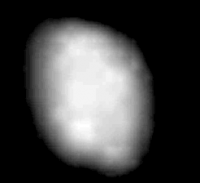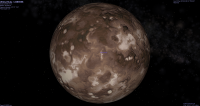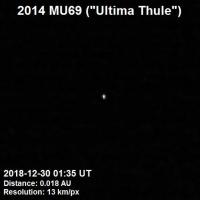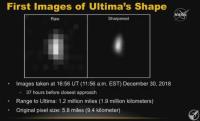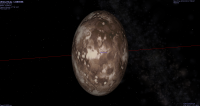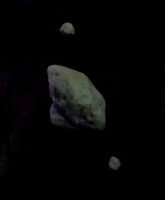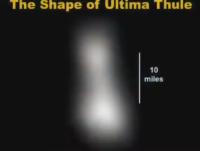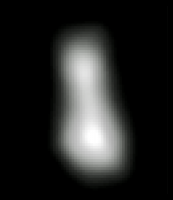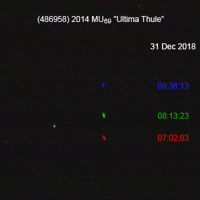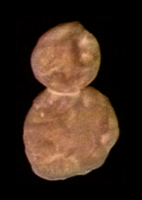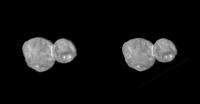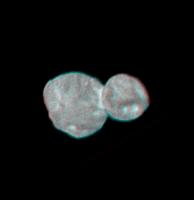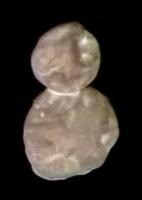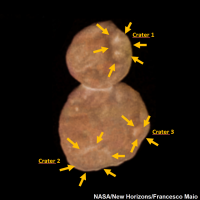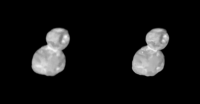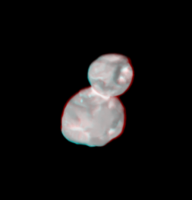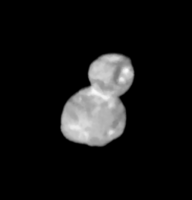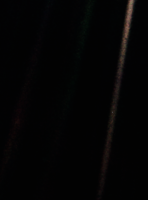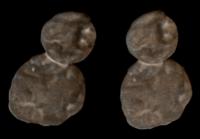Printable Version of Topic
Click here to view this topic in its original format
Unmanned Spaceflight.com _ New Horizons _ 2014 MU69 "Ultima Thule" flyby
Posted by: elakdawalla Dec 13 2018, 10:12 PM
It's only 10 days now until the "Core" phase of the 2014 MU69 flyby begins! I thought it was time for a new thread. http://www.unmannedspaceflight.com/index.php?showtopic=5368, and use this one for MU69 until after the departure phase is officially over on 8 January.
I'll be posting a "What to Expect" article next week.
Posted by: Steve5304 Dec 15 2018, 10:54 PM
How longafter flyby will we get the first image or hint of success?
Posted by: Explorer1 Dec 16 2018, 12:11 AM
Nice overview at the bottom of this post: http://www.planetary.org/blogs/jason-davis/2018/nh-ut-100days.html
Posted by: nprev Dec 16 2018, 02:10 AM
One thing I'm curious about is the anticipated total data acquisition as well as the time that will be required to downlink it at this greater distance. Obviously there won't be nearly as much data as there was from Pluto just because UT is pretty tiny and the near encounter hi-res phase will thus be exceedingly brief, but as with the Pluto encounter I wonder if they're gonna have an expected recorder space used message as part of the survival confirmation message.
Posted by: Alan Stern Dec 16 2018, 03:24 AM
Actually the total data volume taken and stored on the recorders is very close to the same as at Pluto; downloading it all will take 20 months. Through Aug-Sep, 2020.
Posted by: nprev Dec 16 2018, 04:40 AM
Really! Delighted to be wrong, then. Thank you, Alan! ![]()
So there will be an 'expected volume acquired' ping post-flyby as well, then? That was a big moment at Pluto.
Posted by: Explorer1 Dec 24 2018, 06:44 PM
And we have our first mystery: No light curve!
http://pluto.jhuapl.edu/News-Center/News-Article.php?page=20181220
Posted by: fredk Dec 24 2018, 07:09 PM
What about a very slow rotation rate? I didn't see anything about what interval the light curve was taken over. Presumably the lightcurve would look flat if the rotation period was significantly longer than the interval the lightcurve was measured over.
I don't know whether there may be expectations that these objects rotate faster than some rate - if so, that could explain the surprize.
Posted by: Alan Stern Dec 24 2018, 10:30 PM
I don't know whether there may be expectations that these objects rotate faster than some rate - if so, that could explain the surprise.
We have photometry from HST stretching over years and on NH we have been making measurements routinely since September; since later November the SNRs have been quite good. We're looking for periods ranging from ridiculously long (weeks) to ridiculously short (2 hours). Nothing firm yet.
Posted by: NMRguy Dec 25 2018, 05:23 AM
Very curious for better resolution on the shape of the object, if it’s a dumbbell, a binary or something more conventional. The occultation data was certainly curious. Best to the amazing NH team in the coming weeks.
Posted by: scalbers Dec 25 2018, 04:18 PM
I wonder how much difference there is in the Ultima Thule viewing angles presently from New Horizons and the from Earth perspective informing the occultation data? Consideration of this may help constrain a 3-D shape model (and light curve interpretation). The answer to this is a modest about 11 degree difference, since Emily's article mentions an 11 degree phase angle from NH and we can assume a near zero phase angle from Earth.
http://www.planetary.org/blogs/emily-lakdawalla/2018/what-to-expect-new-horizons-mu69-ultima-thule.html
Posted by: Explorer1 Dec 26 2018, 06:36 PM
Nice interview on Planetary Radio, some very good details: http://www.planetary.org/multimedia/planetary-radio/show/2018/1226-2018-alan-stern-new-horizons.html
Posted by: WTW Dec 27 2018, 06:15 PM
Very good Engineering Colloquia presentation by Marc Buie at Space Telescope Science Institute on the challenges re. discovery and tracking of MU69, and of the encounter itself:
https://webcast.stsci.edu/webcast/detail.xhtml?talkid=7547&parent=1
Posted by: nprev Dec 28 2018, 01:37 AM
Emily has posted a http://www.planetary.org/blogs/emily-lakdawalla/2018/new-horizons-approaching-mu69-ultima-thule.html?fbclid=IwAR0YmnyTl3gx1huucUidF9uC2JsgQtc1--jNHeVKv13P4HnqUupAS3SZxM0 providing links to flyby coverage.
ADMIN NOTE: There will likely be no NASA TV or other NASA media coverage of the event due to the partial government shutdown in the United States at this time. All members are reminded to please read and heed rule 1.2. We have to acknowledge this fact, but we will not discuss or debate it.
The Forum is politics-free, and it will stay that way.
Thanks!
Posted by: Explorer1 Dec 28 2018, 02:45 AM
Based on the Administrator's recent tweet, and https://twitter.com/NASAWatch/status/1078476128967368705 I think there might be something on NASA TV after all. The last few shutdowns had no major space events happening, so my guess is that some arrangement must have been made behind the scenes. We'll see if there is actually a briefing tomorrow...
Posted by: nprev Dec 28 2018, 04:09 AM
That would certainly be a most welcome development if it happens; thanks!
In the meantime...UMSF itself is of course a project of The Planetary Society, and we are a part of their education and public outreach efforts. Accordingly, I would encourage all to share any information sources concerning the flyby you can not just here but on your other social media platforms.
Above all else save the success of the flyby itself, it is vitally important that as many people as possible are made aware of this historic event and are afforded the opportunity to witness it. The NH team also should know that they are far from forgotten, and we are all working to spread the word of their work to the world.
It's on. And we, as in each of us, will be a part of making it happen.
GO NEW HORIZONS!!!!
Posted by: MahFL Dec 28 2018, 06:04 AM
Not sure if everyone knows but NASA Eyes does have a MU69 flyby preview and a current live view.
https://eyes.nasa.gov/
Posted by: JRehling Dec 28 2018, 07:02 AM
Before this flyby takes place, I feel a surge of wonderful curiosity about what we will see. The oldest books about the solar system I read as a kid speculated what the surface of the Moon would look like, and similarly had art depicting imagined landscapes of Mars, Mercury, Venus, Titan, and more. I remember the first Viking photos of Phobos and the supposition (not inaccurate) that asteroids would be similar. Pluto most recently brought us unconstrained surprise.
And now we're seeing yet another new kind of world, and this may not happen many more times (constrain that as you will: this century, in any given person's lifetime, or ever). And we just do not know what we'll see. Will it look like a main belt asteroid, but of nitrogen? Strangely eroded? Shaped by electrostatic forces? A globular cluster of pellets slowly orbiting a center? We do not know!
There'll be some wonderful moments ahead, and it may be that nothing is as fun as the anticipation. Anticipate away!
Posted by: nprev Dec 28 2018, 07:37 AM
Undoubtedly. It is a remarkable privilege to be the first of all the humans that ever have lived to see an entirely new type of world for the very first time up close...to say nothing of the fact that KBOs/TNOs were only theoretical concepts until perhaps 40 years ago with the discovery of Chiron. ![]()
We already have one mystery: Why no light curve? Unless NH is flying nearly parallel to UT's rotation axis and/or it just doesn't have any significant albedo variations at all that's a real head-scratcher; other KBOs definitely have them.
Posted by: MahFL Dec 28 2018, 08:41 AM
2.9m miles now... ![]()
Posted by: nprev Dec 28 2018, 03:50 PM
BREAKING: Alan Stern now reporting that NASA social media and NASA TV will indeed cover flyby activities. ![]()
Posted by: dudley Dec 28 2018, 05:26 PM
Perhaps Ultima Thule's lack of a normal light curve means that it's rotating extremely slowly, so slowly that its aspect hasn't changed appreciably since we've had it under observation. Perhaps it's not rotating at all.
Then again, assuming the object is binary in form, perhaps the object's outer-facing hemispheres are lighter in color than those facing each other. This might provide a steady light as it rotates. The light level could be enhanced when less surface area is presented to our view, and detracted from when both lobes are in fuel view.
Judging by the shape model derived from stellar occultation, the two lobes appear to be very close to one another, and to partially overlap, from our point of view.
Posted by: fredk Dec 28 2018, 05:57 PM
Check http://www.unmannedspaceflight.com/index.php?s=&showtopic=8437&view=findpost&p=242740 where he addresses slow rotation.
For sure a cancellation between shape and albedo markings could be to blame, but it does seem unlikely.
Another point is that S/N isn't infinite, so all they can say is that the lightcurve is consistent with flat to some % level, and we don't know what that level is (of course it's decreasing as we approach).
Posted by: nprev Dec 28 2018, 06:07 PM
Slow rotation in itself would be a fascinating find. Most of the asteroids in the inner system we've visited seem to have rotation periods in single-digit hours.
If this turns out to be true then gotta wonder if UT might be completely pristine, as in virtually no impacts or outgassing throughout its history. Alternatively, if it is a contact binary then how was the system's angular momentum dissipated so much?
Posted by: scalbers Dec 28 2018, 06:13 PM
NASA TV Briefing on now...
Posted by: rhr Dec 28 2018, 07:10 PM
On where? I can't find a live stream from any of Emily's links.
Posted by: elakdawalla Dec 28 2018, 07:39 PM
Sorry about that. I did my best with the information provided, but it turned out not to be accurate. Here is a partial recording of today's briefing but it's only 19 minutes' worth -- if anyone finds a full recording, please share it here! https://www.youtube.com/watch?v=N5BNOo4LJmM
Posted by: scalbers Dec 28 2018, 09:55 PM
Looks like a https://www.youtube.com/watch?v=nRgDgrr-i70, now posted on the jhuapl site & https://www.youtube.com/user/jhuapl.
http://pluto.jhuapl.edu/News-Center/Where-to-Watch.php Dec 31 2pm EST.
Posted by: PDP8E Dec 29 2018, 03:54 AM
We have seen several artist's interpretations of MU69 ... a contact binary ... an orbiting binary...
Here is a computer program's interpretation of MU69 ... a programmed hallucination ... but based on inputs of Vesta, Phobos, and the Lorri image released a few days ago (which was 10x if I am not mistaken but was used to constrain the program's output). The program crunched the data for 17 minutes and came up with the image below. This is what MU69 might look like from Lorri at about 50K km away... or probably not.
for your enjoyment only...
Posted by: Explorer1 Dec 29 2018, 04:31 AM
Well, we'll see next week how accurate that is!
Posted by: tanjent Dec 29 2018, 10:20 AM
PDP8E, in the same spirit, I predict that the soon-to-be-revealed observations will bear "some" but "not too much" resemblance to your model image.
Posted by: MahFL Dec 29 2018, 05:13 PM
1.9m miles now. ![]()
Posted by: jasedm Dec 29 2018, 05:55 PM
Were this the Saturn system, we'd be within Iapetus' orbit now...
![]()
Posted by: Lucas Dec 29 2018, 10:29 PM
Interesting tweet from Alan... perhaps they have resolved Ultima Thule?
https://twitter.com/alanstern/status/1079111629604831233
Posted by: MahFL Dec 30 2018, 12:12 AM
https://twitter.com/alanstern/status/1079111629604831233
It seems to be something, but they are still too far out to resolve anything, except maybe if it's a binary or not ?
Also according to Emily's posted schedule no pics are due to be downloaded today.
Posted by: Alan Stern Dec 30 2018, 12:54 AM
Also according to Emily's posted schedule no pics are due to be downloaded today.
Emily's article is about scirct science data. But all data are useful for science, even OpNav images.....
Posted by: dtolman Dec 30 2018, 02:18 PM
Squinting at where the wand is pointing in your twitter post, I'd say LORRI has resolved Ultima Thule into multiple pixels, right on schedule! I guess all will be revealed soon enough
Posted by: fredk Dec 30 2018, 03:24 PM
I don't think he can see where he's pointing.
There appears to be a vaguely ringlike structure about the centre of that image (and darkness at the very centre). My guess: they've subtracted a point-source model (PSF) from the image where MU69 is predicted to be and see a residual around it, which would suggest it's starting to be resolved.
Posted by: john_s Dec 30 2018, 04:49 PM
The raw image page is now up-
http://pluto.jhuapl.edu/soc/UltimaThule-Encounter/
Enjoy!
Posted by: nprev Dec 30 2018, 05:15 PM
Thanks, John. I assume that the fact that UT is near the center of the frame is a very good indication of nav accuracy...? ![]()
Posted by: nprev Dec 30 2018, 06:58 PM
Spaceflight Now is going to https://spaceflightnow.com/2018/12/30/new-horizons-ultima-thule-mission-status-center/?fbclid=IwAR3Lsnx9xoNSYcCY-Eh6qh5o56_mdWIJzA73VkeiONzN692n1YKCO-OrxRM in real time from JHAPL.
Posted by: JohnVV Dec 30 2018, 09:11 PM
artist's concept
do to software constraints a render of UltimaThule as a SPHERE
( this is basically my default KBO generator using Blender )
we will see in a few days , then something much closer to the real thing
PS.
dose anyone know of a naif spice kernel for New Horizon for the fly-by.
The last kernel ( nh_pred_alleph_od124.bsp ) has a end date of September 2018
Posted by: nprev Dec 30 2018, 09:52 PM
Alan just reported on FB that they finished their last nav meeting a few minutes ago, so possible that there might be a REAL fresh one available soon.
Posted by: Bjorn Jonsson Dec 30 2018, 10:25 PM
Interesting tidbit in the Spaceflight Now live-blog from Hal Weaver, there are some hints that Ultima Thule is a quickly-rotating object.
Posted by: Aldebaran Dec 30 2018, 10:56 PM
Could that explain the lack of light curve? (temporal resolution constraints)
Posted by: Bjorn Jonsson Dec 30 2018, 11:29 PM
I doubt it - some of the light curve observations probably include images taken with a short time interval between the images and probably also a variable interval.
But if it turns out that UT really us a quickly rotating object that must be good news since it means NH will be able to observe a bigger part of UT's surface.
Posted by: MahFL Dec 31 2018, 12:02 AM
0.9m miles now.
Failsafe 1 images download starts at 8:31 pm EST.
Posted by: dudley Dec 31 2018, 12:12 AM
How fast would Ultima Thule have to be spinning, I wonder, so that the light curve would be smeared out into one consistent light level?
Posted by: Hungry4info Dec 31 2018, 01:37 AM
It doesn't appear to be a binary object from this image.
(Processed by Daniel Bamberger (stacked, deconvoluted, enlarged)).
Posted by: Explorer1 Dec 31 2018, 03:16 AM
DSN Now shows 1.06 kb/ sec download! This is 'Failsafe 1', right?
Posted by: MahFL Dec 31 2018, 03:30 AM
Correct, download ends at 23:56 EST.
Posted by: WTW Dec 31 2018, 04:58 AM
DSN communication seems to have stopped at 04:43UTC, with several bounces lasting until ~04:47 when the signal dropped.
With the exception of a weird signal drop at ~04:26UTC, signal strength was fairly steady at ~ -147 to -148.5 dBm throughout, indicating good tracking at Canberra and stable pointing by the spacecraft - a good sign...
Posted by: nprev Dec 31 2018, 05:18 AM
Remember that DSN Now is not an authoritative source to determine what's going on with any given spacecraft. See http://www.unmannedspaceflight.com/index.php?s=&showtopic=8391&view=findpost&p=241236 re the Opportunity listening campaign.
It's definitely cool, but anything but official. ![]()
Posted by: angel1801 Dec 31 2018, 06:32 AM
Closest approach is just under 24 hours away. In fact, as of right now it is 23 hours and 1 minute to go.
Posted by: centsworth_II Dec 31 2018, 07:04 AM
"We're looking for periods ranging from ridiculously long (weeks) to ridiculously short (2 hours). Nothing firm yet."
Posted by: nprev Dec 31 2018, 08:33 AM
That's an excellent question. I suppose it would depend on how continuous the dataset was above all else and the rate of sample acquisition; would think that there would also have to virtually no detectable albedo variations at any distance much beyond where NH is right now, which is maybe not too much of a stretch for such a small (and likely primeval) object.
We should hopefully know well before C/A, though. That image Hungry put up looks SORTA maybe kinda oblong if nothing else, so it oughta spin around in a noticeable fashion.
Posted by: paraisosdelsistemasolar Dec 31 2018, 10:59 AM
According to spanish newspaper "Publico", New Horizons is due to land in Ultima Thule tomorrow and also states that was launched in 1996. We've been trying all the morning to get that text updated, but seems impossible. Don't know where they've got all this information.
Anyway, there is a lot of expectation in spanish social media about the flyby, and that is really nice. Good luck for the team!.
Posted by: climber Dec 31 2018, 11:13 AM
Anyway, there is a lot of expectation in spanish social media about the flyby, and that is really nice. Good luck for the team!.
Neither they’ve heard of the Voyagers and Pioneer 10&11th....
Posted by: scalbers Dec 31 2018, 02:43 PM
(Processed by Daniel Bamberger (stacked, deconvoluted, enlarged)).
Interesting to see this result from the deconvolution (deconvolving?), since a number of the neighboring stars appeared to have an L shaped appearance in the raw images.
Posted by: MahFL Dec 31 2018, 05:37 PM
Failsafe 2 should be downloading now.
Posted by: scalbers Dec 31 2018, 05:49 PM
DSN Now (unofficially) indicates the downlink at 500b/sec from Goldstone.
Posted by: nprev Dec 31 2018, 06:40 PM
Fingers crossed that the latest data gives some solid indication of UT's shape and consequently its rotation state.
Posted by: Hungry4info Dec 31 2018, 07:02 PM
Press conference has started.
Posted by: nprev Dec 31 2018, 07:23 PM
It's apparently indeed oblong, at least!
Posted by: Explorer1 Dec 31 2018, 07:24 PM
John Spencer confirms: elongated blob!
Posted by: nprev Dec 31 2018, 07:41 PM
And STILL no apparent light curve. ![]()
Posted by: dtolman Dec 31 2018, 07:50 PM
Now that its shape is apparent, are there explanations left besides it tumbling so slowly that its not apparent in images?
Posted by: Gladstoner Dec 31 2018, 07:53 PM
I wonder if it could be a relatively smooth oblate ellipsoid rotating around the short axis? That could mask a rotation rate until details become resolved.
Here’s hoping for the unexpected...
Posted by: scalbers Dec 31 2018, 07:53 PM
Has the elongation (possible fainter lobe) rotated ~180 degrees relative to the previous image 15 hours earlier? This (together with an absent light curve) would be consistent with a rotation axis aligned with the viewing direction.
NASA TV New Horizons Q&A is to begin shortly at 2015 UTC.
Posted by: Daniele_bianchino_Italy Dec 31 2018, 08:11 PM
ok. . Binary system is excluse?
Posted by: nprev Dec 31 2018, 08:19 PM
No, still possible that it is a binary. Resolution is not yet good enough to determine one way or another.
Posted by: JRehling Dec 31 2018, 09:38 PM
In the absence of any other forces, could solar radiation have halted its rotation in the orientation that presents the least "pressure"? That would indeed be a wacky possibility, but the Yarkovsky effect sounds wacky at first, too.
Posted by: WTW Dec 31 2018, 09:47 PM
Again, a completely "unofficial" indication from DSN NOW:
The download signal from New Horizons seems to have dropped at approximately 21:03UTC. Again, the indicated signal strength was fairly stable throughout at about -147 to -149 dBm.
Almost simultaneously, antenna DSN26 at Goldstone began transmitting a very strong (79kW) signal directly toward MU69 and New Horizons -- presumably for the radio science experiment when that signal arrives hours later.
And meanwhile, it appears that all four antennas at Canberra are all aligned and arrayed and tracking New Horizons as it climbs above the Earth's horizon.
I know that DSN Now is not in any way definitive (and can be misleading), but these folks are actively involved in this endeavor. They never get to be up on the platforms at news conferences, but they are crucial. And fun to watch.
Posted by: Explorer1 Dec 31 2018, 09:51 PM
That far out from the Sun, I doubt that there's any significant pressure from light, at least for a natural object. We don't know of any slow rotaters beyond the Trojans.
Though given 4.5 billion years, many things are possible....
Posted by: nprev Dec 31 2018, 10:44 PM
If it is indeed a slow rotator AND it's binary/contact binary that's even more puzzling just from a conservation of momentum standpoint. Would have had to have been an extremely low-velocity capture indeed and one or both of them had to be barely rotating in the first place.
I suppose it's possible that there were one or more encounters with or impacts by other objects at some point in the distant past that hit all the various vectors just right to create this hypothetical binary, but it is very empty way out there, not like the inner system at all. Not really buying that scenario.
Posted by: scalbers Dec 31 2018, 10:52 PM
If it's a (non-contact) binary we'd be referring to a slow orbital revolution rather than rotation. My odds would favor a peanut shaped single object, like Halley or Borelli. This would mean a sizeable neck if it is a contact binary. At least so far there hasn't been any hint of a saddle point or minimum of pixel intensity between the two "lobes".
Posted by: Explorer1 Dec 31 2018, 10:57 PM
Less than 1 lunar distance now; 7 hours to close the remaining gap, just like after launch (Newton's First Law ![]() )
)
Posted by: Floyd Dec 31 2018, 10:58 PM
At the press conference Dr. Spencer used a pen to demonstrate how if it rotates perpendicular to its long axis, and the rotation axis is facing you, you see the same surface all the time.
Posted by: HSchirmer Dec 31 2018, 11:14 PM
Hmm, evaporation from the sunrise side removes mass and momentum, transfers it to the evening-side via condensation....
"In Lower Pomerania is the Diamond Mountain... every hundred years a little bird comes and sharpens its beak on it"
The Brothers Grimm
"You must think that's a helluva long time!... Two Billion years...Personally? I think that's a helluva bird"
Steven Moffat/Peter Capaldi
Posted by: MahFL Dec 31 2018, 11:23 PM
Less than 200K miles now.
Posted by: angel1801 Jan 1 2019, 03:40 AM
One hour and 53 minutes to closest approach now.
Posted by: Gladstoner Jan 1 2019, 03:46 AM
I'm imagining it as something with a form like Methone, but probably not as smooth. Perhaps this vast and remote neighborhood could have been quiet enough through the ages to prevent any disruptions that would result in an irregular form.
Posted by: Decepticon Jan 1 2019, 03:57 AM
I expect a crater-less comet like object.
Posted by: MahFL Jan 1 2019, 04:34 AM
I predict more than 1 crater.
Posted by: Explorer1 Jan 1 2019, 04:34 AM
Less than an hour left....
Posted by: Aldebaran Jan 1 2019, 05:15 AM
Surrounded by millions of tiny orbiting particles
Posted by: MahFL Jan 1 2019, 05:20 AM
Hope not as NH would be destroyed.
Posted by: angel1801 Jan 1 2019, 05:24 AM
Only 9 minutes or just over 9000 KM to closest approach now.
Posted by: MahFL Jan 1 2019, 05:38 AM
Gratz to the NH team, hopefully everything worked ok.
Posted by: nprev Jan 1 2019, 06:06 AM
We wait on the beach of a midnight sea, anxiously awaiting the faintest of comforting whispers from our small, small ship as she passes a distant, mysterious island faster than dreams, far beyond our horizon
Good luck.
Posted by: Tom Ames Jan 1 2019, 07:51 AM
Good luck.
That's beautiful, and a wonderful and optimistic sentiment with which to start the new year. Thank you.
Posted by: Daniele_bianchino_Italy Jan 1 2019, 08:41 AM
Good luck.
A Good words.. Many Thanks . .����
Posted by: nprev Jan 1 2019, 03:20 PM
Acquisition of signal for 'phone home' expected at approx. 1535 GMT, NASA TV live coverage beginning now! (1520 GMT)
Posted by: nprev Jan 1 2019, 03:31 PM
Carrier!
Posted by: nprev Jan 1 2019, 03:32 PM
TELEMETRY LOCK!!!
Posted by: Explorer1 Jan 1 2019, 03:33 PM
Telemetry coming down....
Posted by: nprev Jan 1 2019, 03:36 PM
RECORDER POINTERS AS PREDICTED, EXPECTED AMOUNT OF DATA ACQUIRED!
Posted by: nprev Jan 1 2019, 03:40 PM
Looks good. Applause and hugs. Science downlink expected 2000 GMT today.
Happy, happy New Year! ![]()
Posted by: Steve G Jan 1 2019, 03:55 PM
How bright is Ultima Thule to an observer with human eyes? (If we can get a common frame of reference and not the math.) As bright as the light from a full moon? Or, if I had a camera with ISO 100 at F4, what would be my shutter speed?
Posted by: dudley Jan 1 2019, 03:57 PM
With the news that New Horizons has survived its close encounter with Ultima Thule, with all systems intact, a dense particle cloud now seems to have been rendered very unlikely.
Posted by: Bjorn Jonsson Jan 1 2019, 03:58 PM
Awesome news, apparently the spacecraft did everything it was supposed to do.
Posted by: Nafnlaus Jan 1 2019, 04:15 PM
Do you mean, if you were located at a position where it took up the same amount of steradians as the moon does from Earth? Is this in a scenario where it's at 1AU like the moon, or where it actually is at present? I don't think we can give an answer to either scenario yet (has the albedo been determined?)
Posted by: fredk Jan 1 2019, 04:19 PM
It's around 43.4 AU from the sun, so sunlight at its surface would be close to 1/1900th as bright as at Earth. That corresponds to nearly 11 photographic stops fainter. So still quite a bit brighter than under a full moon at Earth, which would be around 18 or 19 stops fainter than full sunlight.
Posted by: Explorer1 Jan 1 2019, 04:35 PM
Latest image on NASA TV! Looks like a bowling pin.
Hal Weaver says the pole is facing us (explanation for the light curve mystery).
Posted by: Hungry4info Jan 1 2019, 04:38 PM
We can see the rotation. Rotation period is either 15 hours or 30 hours.
Posted by: fredk Jan 1 2019, 04:42 PM
More like somewhere between 15-ish and 30-ish hours - they didn't observe it at the higher resolution for long enough to pin the rate down well.
They said they're still not sure whether it's one or two bodies. Now that we have a (crude) rotation rate and a good size, it shouldn't be hard to estimate whether the periodicity is consistent with Kepler for two bodies, assuming something about density...
Posted by: fredk Jan 1 2019, 04:55 PM
Though of course the uncertainties on linear size are still large, and the uncertainties on volume (and hence mass) will scale like the cube of the linear size (and depend on the full 3-D shape), so will be huge.
Posted by: ElkGroveDan Jan 1 2019, 04:57 PM
Another round of high-fives for Alan Stern and his team.
Posted by: Themisto Jan 1 2019, 06:05 PM
Looks to me that this might indeed be a binary.
When using this equation: P^2 = [ 24 pi R^3 ] / [ G rho (D1^3 + D2^3) ]
(with P = period -- 15 h or 30 h; R = range between component centers; G = 6.67e-11 m3/kgs2; rho = object density; D1 = diameter of larger, D2 = diameter of smaller component),
then, a P near 15 h can be achieved with the following values:
Assume rho = 0.6 g/cm3 => values for the range and sizes:
R ...12 -- 13 -- 14 -- 15 km
D1... 9 -- 10 -- 11 -- 12 km
D2... 7 -- 7 -- 8 -- 8 km
For P ~ 30 h and rho ~0.5, possible values are:
R ...16 -- 17 -- 18 -- 19 km
D1... 9 -- 9 -- 9 -- 10 km
D2... 5 -- 6 -- 7 -- 7 km
For a density similar to Phoebe's (1.6 g/cm3), the 15 h period might work like this:
R=18 km
D1=10 km
D2=7 km
The 30-h period at 1.6 g/cm3 does not appear to look compatible with the image to me:
R=18 km
D1=6.5 km
D2=4 km
Not surprising, it appears that we need the better images (plus the exact period) to get solid numbers. In the meantime, excitement remains that Ultima Thule might indeed be a double object.
~~ Tilmann
Posted by: JRehling Jan 1 2019, 06:25 PM
If it is a double object, they should dub the two parts "Ultima" and "Thule." (Like Buda and Pest.)
Posted by: scalbers Jan 1 2019, 06:28 PM
The ground illumination should look like about 10 minutes after sunset on Earth.
Posted by: PDP8E Jan 1 2019, 06:44 PM
this is amazing... to the New Horizon Team! To the builders, the managers, the engineers, and to the thousands running the infrastructure that to talks to that little beauty! We need more of these machines... to bring our eyes out there! Well done!
Posted by: Themisto Jan 1 2019, 06:48 PM
https://planetary.s3.amazonaws.com/assets/images/9-small-bodies/2018/20190101_mu69-rotation_f233.gif
Here, it really looks like a contact binary. We will see... ![]()
Posted by: Daniele_bianchino_Italy Jan 1 2019, 06:52 PM
Very interest the hypotetical luminosity over these astronomical distant corps.
Posted by: Daniele_bianchino_Italy Jan 1 2019, 06:55 PM
Here, it really looks like a contact binary. We will see...
I hope in a low distant binary, not in contact ��
Posted by: Themisto Jan 1 2019, 08:11 PM
Me too :-)
If the rotational axis is not pointing toward the observer, but rather somewhere in between of "toward observer" and "perpendicular to observer", then a binary might make sense also with respect to the non-detection of a lightcurve. In the animated-gif, "Ultima" passes in front of (or behind) "Thule", but the two components do not yet occult each other (at least not significantly). As long as the individual components are rather spherical, this would result in a rather shallow lightcurve because no "additional surface parts" would appear while the components move toward maximum elongation. Since no occultation took place, the characteristic dips of binary lightcurves are not there. Same for lightcurve features from potential eclipses since the sun is behind the observer.
Another 2 cents...
Posted by: WTW Jan 1 2019, 08:19 PM
DSN Now is reporting start of the NYT 1 ("New York Times") data downlink. Signal strength is in the about -147.5 to -149 dBm range, as usual, and bit rate is shown as 841 bits/sec. The first post-flyby science data download has begun!
Posted by: AndyG Jan 1 2019, 08:22 PM
If you've witnessed a near-total-eclipse, you may well have spotted something 'odd' with the light and shadows. A slither of Sun casts much sharper shadows than the full half-degree disk. At Ultima Thule, whilst the daylight will be dimmer, by about 8 magnitudes, the shadows will be very much sharper.
Andy
Posted by: Aldebaran Jan 1 2019, 08:43 PM
That's not a useful analogy because it ranges from pitch black to daylight depending on season and latitude. It's more like a very dark rainy day.
Posted by: Daniele_bianchino_Italy Jan 1 2019, 08:45 PM
Andy
Non lo sapevo. . incredible!
Posted by: Aldebaran Jan 1 2019, 08:48 PM
Looks like a raw peanut in shape. How long before we know if the peanut is in one piece or broken?
Posted by: paraisosdelsistemasolar Jan 1 2019, 08:49 PM
First I want to say congratulations to Alan and all the team for this flyby. Again in Spain has been a trending topic during the afternoon today.
I have made a quick and dirty way to look to all the images that are going to be downloaded from New Horizons that is useful if you want to sort by distance, date or exposure. The database will be uploaded as soon as there are new images avaiable: http://nahumchazarra.com/ultimalorri/viewer.php
Posted by: JRehling Jan 1 2019, 08:51 PM
Post-sunset brightness also depends upon transparency (humidity, dust). It's still useful, if not precise, for relating to all of us that it is certainly bright enough to see things.
Terrestrial sunlight is 400,000 times brighter than a full Moon, so the sunlight at Ultima Thule is about as bright as 210 full Moons. None of us, I think, have ever seen 210 full Moons at the same time, but as it's possible to read by the light of the full Moon, it certainly conveys that it's not such a dark place.
Put another way, it's about half as bright as sunlight at Neptune. If you've ever seen Neptune through a telescope, you can see that it's quite adequately lit for seeing shape and color.
Posted by: MarkG Jan 1 2019, 09:06 PM
Just about out of time for wild speculation, so Iʻll give it a last minute whirl....
Methinks that a close binary orbit would be short-lived (on the age-of-solar-system scale) because of small dissipative forces in the "neck" area. Debris could gather there and bounce around.
I am sure there would be cratering events in the history of MU69, but ice condensation/evaporation features cold also be present, plus solar wind and cosmic ray "processing". What the result of this looks like is truly anybodyʻs guess -- the best answer is "we donʻt know, but we will find out soon"....
Posted by: scalbers Jan 1 2019, 09:53 PM
I can be a bit more specific if it will help. If a spot on UT is normal to the sunlight, the illumination is about the same as a typical location on Earth in cloudless conditions with reasonably clean air having the sun about 1.5 degrees below the horizon. While it's true that aerosols and other factors change this I think the illumination normal to the ground will usually be within a factor of 2 of the nominal value. Perhaps I should try and check this with my sky simulation software and/or some pyranometer measurements.
It's kind of rare for a rainy day to be this dark (<0.1% of full zenithal sun) unless the sun is fairly close to the horizon. I'd place more typical values in cloudy/rainy conditions at 3-10% of the full sun case.
Posted by: Themisto Jan 1 2019, 10:06 PM
Methinks that a close binary orbit would be short-lived (on the age-of-solar-system scale) because of small dissipative forces in the "neck" area. Debris could gather there and bounce around.
Disspiative forces even in case of a doubly-synchronous binary system with perfectly circular orbits?
A "wild speculation" for the moment:
Ultima Thule is a binary with two similarly-sized (but not equal-sized) components in a doubly synchronous rotation state with a period at the order of 16 hours and a pole-axis orientation that is approximately 45 to 60 degrees away from the observer (aka ~30° to ~45° tilted to the ecliptic plane). Diameter of larger component ~14 km, of smaller ~10 km; center range ~21 km, density ~0.8...0.9 g/cm3.
(Ok, this is really speculative...)
Posted by: HSchirmer Jan 1 2019, 10:21 PM
Hmm, we're expecting to see the oldest solid surface yet found in the solar system...
A cold classical Kuiper-belt binary, which has been in basically the same orbit for billions of years.
Hmm, this should be the first time we see what happens when sunlight and solar wind are the main weathering mechanism.
That should be a red-tholin-surface dominated by space weathering on the sunward side.
Might have some interesting long term torquing effects if material evaporates or sputters from the sunward side and collects on the dark side, might even have a "lake" of dust collecting in the neck between the main lobes.
Posted by: Mongo Jan 1 2019, 10:57 PM
Terrestrial sunlight is 400,000 times brighter than a full Moon, so the sunlight at Ultima Thule is about as bright as 210 full Moons. None of us, I think, have ever seen 210 full Moons at the same time, but as it's possible to read by the light of the full Moon, it certainly conveys that it's not such a dark place.
Put another way, it's about half as bright as sunlight at Neptune. If you've ever seen Neptune through a telescope, you can see that it's quite adequately lit for seeing shape and color.
The full moon produces about 0.1 lux illumination, so sunlight at Ultima Thule would be around 21 lux. This is between "twilight" (~10 lux) and "very dark overcast (~110 lux). Dimly lit publlc areas run between 20 to 50 lux, and home interiors are around 150 lux.
Posted by: Daniele_bianchino_Italy Jan 1 2019, 11:00 PM
Im not very expert but unfortunately I think that two object very close aren't stable. I think necessary almost 30km space between two 10-15 km binary object for stability. But if they were two bodies so far away they were already resolved divided. This is why I believe that they will be two bodies in contact as a skittle or an hourglass.
I expect like-sand dune area like same little area over 67P comet
Posted by: MahFL Jan 1 2019, 11:35 PM
NYT 1 data download should be on the ground now.
Posted by: HSchirmer Jan 2 2019, 12:02 AM
As of a few minutes ago, NASA's DSN-now webpage showed the s 70 meter antenna at Goldstone had just finished a downlink with New Horizons...
LORRI gallery still showing 57 images down, 52 available to browse...
http://pluto.jhuapl.edu/soc/UltimaThule-Encounter/
Posted by: WTW Jan 2 2019, 01:50 AM
And NYT 2 downlink has begun, with stable signal and an indicated data rate of 1.06kb/sec. Should be a good news conference tomorrow :-)
Posted by: HSchirmer Jan 2 2019, 02:58 AM
Will be interesting to see how close the prior predictions are...
https://arxiv.org/ftp/arxiv/papers/1808/1808.02118.pdf
Posted by: dolphin Jan 2 2019, 04:15 AM
Well done project team!
Posted by: nprev Jan 2 2019, 05:20 AM
Anybody seen an announcement for the next news conference, presumably sometime tomorrow morning East Coast US (2 Jan/GMT-4)? Been looking, haven't found anything.
Posted by: Explorer1 Jan 2 2019, 05:28 AM
Emily's post says 2:00 PM EST, and that's what I'm counting on. Her table hasn't been wrong yet!
Posted by: nprev Jan 2 2019, 05:32 AM
Yes, that is classic Emily. ![]() Was wondering if perhaps there was gonna be a pop-up coinciding with the initial data reception, but a- of course there must be some preparation and more importantly b- the team probably should get some sleep since they've been up for like a week or so.
Was wondering if perhaps there was gonna be a pop-up coinciding with the initial data reception, but a- of course there must be some preparation and more importantly b- the team probably should get some sleep since they've been up for like a week or so. ![]()
Thanks!
Posted by: WTW Jan 2 2019, 06:11 AM
The New Horizons web site at http://pluto.jhuapl.edu/News-Center/Where-to-Watch.php also still shows press briefings at 2:00-3:00PM EST on both Wednesday 2 Jan. and Thursday 3 Jan.
The news briefing tomorrow (Wednesday) will happen while the NYT 3 downlink is still in progress; hopefully we'll see those LORRI + MVIC images on Thursday, and maybe even some first LEISA and SWAP/PEPSI results.
Posted by: climber Jan 2 2019, 08:00 AM
A tweet from James Tuttle Keane: Finishing a long night of analyzing new images of #UltimaThule. I can’t wait for you all to see. For now, here’s a teaser...
In case you don’t follow James, he draws sketches...
Hard to make hypothesis but at least it seams UT is not white only !
Posted by: WTW Jan 2 2019, 08:49 AM
NYT 2 just finished. Signal dropped at Canberra at about 08:35UTC.
Indicated signal strength was as low as about -150 dBm for a short period, but was in general very stable at previous nominal levels throughout the 6 hrs 45 min. The entire communications pass was via the Canberra 70m dish.
Noticed that data rate dropped to an indicated 841 bps just before 05:51 UTC, and then to 501 bps at about 07:26UTC. Very stable after each change.
Posted by: Themisto Jan 2 2019, 09:41 AM
It appears we all are now part of a modern ("spacy") version of the https://en.wikipedia.org/wiki/Stanford_marshmallow_experiment...
Posted by: Themisto Jan 2 2019, 10:17 AM
From the "Failsafe 2" raw-image data set (2x zoomed; co-registered to inertial stars)
Posted by: Y Bar Ranch Jan 2 2019, 01:34 PM
A pile of pencil shavings?
I now have this mental image of a brave little group of icy bits huddled up in a little gravity well for comfort against the cold, dark void.
I guess I can anthropomorphize anything...
Posted by: YesRushGen Jan 2 2019, 02:13 PM
In case you don’t follow James, he draws sketches...
Hard to make hypothesis but at least it seams UT is not white only !
My not-so-educated-guess:
Large lobe has a jagged appearance (pencils) - maybe with a single "spike", small lobe is "lumpy" (pencil shavings) and the middle is regolith-like fine material.
Posted by: Daniele_bianchino_Italy Jan 2 2019, 02:43 PM
Ummm
��
https://twitter.com/i/status/1080464926739709952
Posted by: Blue Sky Jan 2 2019, 02:44 PM
My guess is that a lot of medium-sized bodies will turn out to be peanut-shaped like this, possibly with very different makeup of the lobes with different origins. Itokawa, 67P/Churyumov–Gerasimenko, Ultima Thule...
Posted by: Daniele_bianchino_Italy Jan 2 2019, 03:24 PM
Ummm like evident contact object; no binary distant
Posted by: Bjorn Jonsson Jan 2 2019, 03:30 PM
Judging from what Alan Stern posted on FB, the press conference later today is probably going to be really interesting.
Posted by: volcanopele Jan 2 2019, 03:33 PM
Judging from Roman's processing, it looks like the neck is quite a bit darker than the two lobes, especially looking at that last image. Could be a roughness affect, neck smoother (mostly dust) while the lobes are rougher.
Posted by: Daniele_bianchino_Italy Jan 2 2019, 03:43 PM
I remember the Hartley comet form:
. .
Posted by: Req Jan 2 2019, 04:02 PM
Quote? Link? I'm not finding his profile via google or people search on facebook, and the link from "contact" on his personal .space domain does not work.
Posted by: stevesliva Jan 2 2019, 04:08 PM
Alan Stern Facebook: https://www.facebook.com/s.alan.stern
Posted by: Req Jan 2 2019, 04:10 PM
I just get "Page Not Found" - same link that's on his site. That's fine, I can wait for the press conference.
Posted by: kenny Jan 2 2019, 04:21 PM
I got it OK from that link. This is Alan's intriguing message :
" Planetary science fans-- I think you definitely want to tune in to our press conference about Ultima Thule today, 2 pm Eastern. Just one thing, before you do, fasten your seat belts! "
Posted by: mcaplinger Jan 2 2019, 04:36 PM
What did you expect him to say? I'm sure it will be interesting, but I wouldn't read much into this.
Posted by: Nafnlaus Jan 2 2019, 05:02 PM
Well, he certainly disappoint with Pluto... sure, there was hype, but it was well warranted. Based on his post, I'm expecting at least something quite "unexpected" / "out of the ordinary".
Posted by: HSchirmer Jan 2 2019, 05:03 PM
��
https://twitter.com/i/status/1080464926739709952

Ummm... Yeah...
They're Spaceballs...
They're twirling Spaceballs.... (I assume this is funnier in Italian)

-Voiceover-
The unexpected collaboration between Alan Stern and Mel Brooks.....
Behold the twiriling spaceballs, Skroob and Yogurt
Posted by: Daniele_bianchino_Italy Jan 2 2019, 05:04 PM
I agree with you.
I hope so..
Posted by: scalbers Jan 2 2019, 05:16 PM
To somewhat nail down the illuminance in lux we can start with the solar constant of 1360 W/m^2 at 1AU. This is 0.85 W/m^2 at 40AU (dividing by 1600). For a solar spectrum we can convert the irradiance (W/m^2) to illuminance (lux) dividing again by .0079. This works out to about 108 lux at UT.
A similar calculation for an Earthly full moon (1/400000 of the sun at 1AU) is 0.43 lux.
Posted by: HSchirmer Jan 2 2019, 05:19 PM
The unexpected collaboration between Alan Stern and Mel Brooks.....
On second thought, a better choice for the voiceover-
Here, in a world where the sun burns cold, and the wind blows colder, a visitor has come..."
https://www.youtube.com/watch?v=Ipv1y-Phi7A
Posted by: moustifouette Jan 2 2019, 05:53 PM
Pluto results were mostly unexpected and so much over expectations... think about the pristin nitrogen ice cap of Spunik planitia, with its convection cells and water icebergs.. Add a heart and the hazy atmosphere... It was just amazing.
Posted by: Nafnlaus Jan 2 2019, 06:06 PM
Pluto results were mostly unexpected and so much over expectations... think about the pristin nitrogen ice cap of Spunik planitia, with its convection cells and water icebergs.. Add a heart and the hazy atmosphere... It was just amazing.
Exactly. I can't imagine this coming even close to beating that. But there may still be some neat surprises in store.
Posted by: Explorer1 Jan 2 2019, 06:07 PM
Alan you sneaky PI!
https://twitter.com/AlanStern/status/1080515566518104065
Hint: the monitor in the 1st image...
Posted by: JRehling Jan 2 2019, 06:17 PM
Just stirring up excitement with 45 minutes to go, but I'm supposing that "fasten your seatbelts" might be saying something about the asteroid and parts of it being in a state of [near] escape rather than (solely) about our emotional states.
Posted by: Bjorn Jonsson Jan 2 2019, 06:27 PM
Well, it really is impossible to tell what this is. Could be an enlarged view of UT but might also be something else.
And regarding the FB post I mentioned earlier (and which generated some discussion here), I simply took it to imply that at least they have interesting data and which also would mean that the instrument pointing was correct. Of course (given the "phone home" telemetry) this was very likely to be the case - after all these are not the highest resolution images/data.
But the main thing is that I'm excited and eagerly waiting to watch to press conference that starts in 35 minutes
Posted by: Daniele_bianchino_Italy Jan 2 2019, 06:45 PM

They're twirling Spaceballs.... (I assume this is funnier in Italian)
eheh yea.. balle spaziali
Posted by: Betelgeuze Jan 2 2019, 06:51 PM
Anyone got a link to the press briefing? It should start in 10 minutes, but nothing available on the NASA youtube channel yet.
Posted by: Therion Jan 2 2019, 06:53 PM
Here are scientific papers available before the flyby:
https://arxiv.org/pdf/1805.02252.pdf (http://planetary-mechanics.com/2018/06/24/locating-ultima-thule)
https://arxiv.org/pdf/1806.09684.pdf
https://arxiv.org/ftp/arxiv/papers/1806/1806.08393.pdf
https://arxiv.org/ftp/arxiv/papers/1808/1808.02118.pdf
https://arxiv.org/ftp/arxiv/papers/1812/1812.04752.pdf
https://arxiv.org/ftp/arxiv/papers/1812/1812.04758.pdf
https://arxiv.org/pdf/1812.09785.pdf
How close were all the predictions? How many papers will come up during 2019?
Posted by: Nafnlaus Jan 2 2019, 06:56 PM
Intro graphic just showed up on NASA TV:
https://www.youtube.com/watch?v=21X5lGlDOfg
Posted by: scalbers Jan 2 2019, 06:57 PM
I see it here: https://www.nasa.gov/multimedia/nasatv/index.html#public
Posted by: nprev Jan 2 2019, 07:00 PM
Live now.
Posted by: Nafnlaus Jan 2 2019, 07:02 PM
I find it mildly amusing that I'm watching this from the real Ultima Thule (Iceland) ![]()
Posted by: nprev Jan 2 2019, 07:04 PM
Contact binary!
Posted by: Bjorn Jonsson Jan 2 2019, 07:05 PM
Wow, this is a really weird object...
Posted by: dtolman Jan 2 2019, 07:05 PM
Wow - so it really was a contact binary - believe that's another first for a probe!
Posted by: Bjorn Jonsson Jan 2 2019, 07:05 PM
You're not the only one
Posted by: dtolman Jan 2 2019, 07:13 PM
Interesting that there are no obvious impact craters - though perhaps some smaller ones will become more apparent as the angle of sunlight changes in the images.
Posted by: Nafnlaus Jan 2 2019, 07:13 PM
"No obvious impact craters" - huh...
Posted by: nprev Jan 2 2019, 07:20 PM
The hi-res shots will probably show some, but not many. Think we're looking at two icy planetesimals that got starved out before they ever encountered others.
Posted by: Bjorn Jonsson Jan 2 2019, 07:21 PM
As was mentioned at the press conference, it's going to be especially interesting to see images where the illumination is different and shadows are visible.
Posted by: Nafnlaus Jan 2 2019, 07:24 PM
Even in the Kuiper Belt, collisions occur. Look at Pluto.
Perhaps sublimation-driven snow could be burying them? ED: No, that shouldn't work. Surely it has no more than the faintest of exospheres, so sublimed ices should just escape.... exosphere = collisions are statistically rare = particle aggregation is rare.
Posted by: xflare Jan 2 2019, 07:25 PM
This makes the results of the occultation experiments all the more extraordinary
Posted by: MichaelJWP Jan 2 2019, 07:29 PM
Taking a step back, this is absolutely awesome stuff:)
Thinking once in a lifetime.
Posted by: machi Jan 2 2019, 07:29 PM
Quick and dirty color composite of the highest published resolution image from LORRI colorized by RALPH color.
Congratulations to the New Horizons team for another great flyby!
Posted by: nprev Jan 2 2019, 07:29 PM
Perhaps sublimation-driven snow could be burying them?
Pluto's in a different class entirely in many ways since it likely had some sort of dynamic interaction with (at least) Neptune in the distant past, the system itself shows abundant evidence of relatively large-scale collisional events, and of course it's got a lot more surface area to take hits. Cold classical KBOs like UT may be considerably less cratered.
Posted by: Spock1108 Jan 2 2019, 07:30 PM
A first processing between the best image released in black and white and color...
It seems to see a crater in the lower left corner on the lobe Ultima!!
FANTASTIC!
Edit: Image V2
Posted by: Nafnlaus Jan 2 2019, 07:34 PM
They just talked about craters, but I didn't quite catch whether he was saying that the low level of cratering should be expected or not....
I guess we'll find out when they get a better crater count.
Posted by: vikingmars Jan 2 2019, 07:35 PM
Yes : So primitive too
CONGRATULATIONS to the NH team for this incredible feat
Posted by: dtolman Jan 2 2019, 07:42 PM
There were two discussions - one basically said that a low rate of cratering is expected in for Ultima Thule considering its location in the Kuiper Belt versus the classic Asteroid Belt objects, and another caveat from Alan Stern that the lighting was such that craters would not be apparent, not that they aren't there - and that will change as they get images that were taken later in the flyby.
Posted by: MahFL Jan 2 2019, 07:44 PM
I guess we'll find out when they get a better crater count.
I think he said the theoretical cratering rate there was generally pretty low, so to see few craters would not be unexpected.
Posted by: JRehling Jan 2 2019, 07:55 PM
How much fun would it be to stand at the junction between the two components and push them apart?
Posted by: Explorer1 Jan 2 2019, 07:59 PM
Yeah, it would be fun... but you might need a pretty big crowbar!
I am reminded of Robert Forward's 'Rocheworld', though clearly much less symmetrical.
Posted by: fredk Jan 2 2019, 08:00 PM
Stereo views from NYT1 and 2. Quite noisy, but we are seeing some subtle stereo, especially in the smaller ball (Thule).
Cross-eyed:
and anaglyph:
Posted by: Steve G Jan 2 2019, 08:03 PM
Successful Ultima Thule flyby, OSIRIS-REx enters orbit around Bennu, Chang'e 4 about to land on the lunar farside. Just another ho-hum week in space exploration.
Posted by: stevesliva Jan 2 2019, 08:28 PM
A couple notes from when they discuss this image versus the best to come.
This image was ~50k km range 1hr to closest approach. It is 28k pixels with a resolution of 140m/pixel.
CA06 observation yet to come hopefully delivers 1M pixels at 35m/pixel.
Another presser tomorrow with perhaps better topography. Not sure when CA06 coming.
Posted by: Habukaz Jan 2 2019, 08:38 PM
When I look at the highest-resolution picture, I see many arcuate shapes. I bet on many craters visible in the more topography-friendly images.
Posted by: Webscientist Jan 2 2019, 08:41 PM
Have there been several contacts between the bodies?
Apparently, at first sight, the relatively circular shape of the contact area implies that the crash trajectory must have been roughly perpendicular to the surface of the bigger rock or object (volume about 3 times higher according to Alan Stern).
Posted by: Daniele_bianchino_Italy Jan 2 2019, 08:48 PM
For superstition I did not to see the new images. Now I ask you: how much had you thought you was surprised by Ultima from 1 to 10 and how much you actually were (from 1 to 10)? many Thanks
(I see new image after yours reply ![]() I with my hand have covered the images above
I with my hand have covered the images above ![]() )
)
Posted by: Toma B Jan 2 2019, 08:51 PM
If I understand this correctly, that image of MU69 was taken from the distance of 28.000 km, and closest flyby was at 3500 km at its closest.
That means that image taken at closest approach should be about 8 times the resolution of what we are seeing now?
BTW you guys are AWESOME!!!!
Posted by: Webscientist Jan 2 2019, 08:55 PM
7/10 A first for sure!
(I see new image after yours reply ���� )
Posted by: Tom Tamlyn Jan 2 2019, 09:47 PM
Youtube link to today's press conference.
https://www.youtube.com/watch?v=kSHOOFBxRvA
Posted by: fredk Jan 2 2019, 09:49 PM
First unambiguous one? There are also 67P/Churyumov–Gerasimenko and 25143 Itokawa as potential contact binaries.
Posted by: xflare Jan 2 2019, 10:15 PM
Maybe a large crater on the smaller lobe?
Posted by: Gladstoner Jan 2 2019, 10:16 PM
Which side was imaged during closest approach?
Posted by: Nafnlaus Jan 2 2019, 10:24 PM
As mentioned in the conference, what's exciting about this is that this is a "primitive" contact binary, whereas bodies like 67P/Churyumov–Gerasimenko and 25143 Itokawa - if they are contact binaries - are evolved. Ultima Thule could prove key to understanding such bodies - whether they actually are originated as contact binaries, and if so, how they evolved from there to their current forms.
Posted by: vikingmars Jan 2 2019, 10:24 PM
I would rather refer to hollows, bumps and wrinkles on such a primitive body like this one, if I may say...
Posted by: pbanholzer Jan 2 2019, 10:45 PM
Toma - In the press conference they said 35 m/px will be the highest resolution , so 4x today's image.
Posted by: pbanholzer Jan 2 2019, 10:50 PM
I've wondered if some of the apparent bumps are remnants of previously accreted smaller bodies. But I realize that topography may require low sun angle images.
Posted by: HSchirmer Jan 2 2019, 10:59 PM
I suspect that already happens.
Just wait until somebody calculates the insulation curves for the entire orbit.
Given the angular momentum of a binary, it should act like a gyroscope as it goes around the orbit.
In simpler terms, to understand Utima Thule, you have to think about meat on a barbecue...
UT spends half of its time rotating and roasting horizontal to the sun like a chicken on a spit.

UT spends the other half of its time rotating and roasting vertical to the sun like a donner kabob

When UT is roasting "vertically" the cryo-ice 'drippings' accumulate at the neck.
I suspec they exert quite a torque when they warm up one-quarter of an orbit later.
Posted by: serpens Jan 2 2019, 11:16 PM
That is a very good point. Although the closure rate would be very low as pointed out in the presentation, if there was any residual rotation rate in one or both bodies then one could imagine an extended period of contacts and transfer of angular momentum until the two bodies settled down.
Posted by: David Wright Jan 2 2019, 11:27 PM
I haven't seen any explanation of how angular momentum is lost, allowing a co-rotating pair of objects to spiral together and touch.
Posted by: Explorer1 Jan 2 2019, 11:35 PM
I've wondered this too: once both bodies are tidally locked to one another (as Pluto and Charon were very quickly after formation), wouldn't they remain stable, barring a close encounter or collision with an interloper?
Posted by: HSchirmer Jan 2 2019, 11:36 PM
Eh, Sunlight? (Carl Sagan voice) Billions and billions of photons...over quadrillions and quadrillions of time intervals...
The side spinning towards the sun is blue-shifted, the side spinning away is red shifted.
More energy and thus more force, is experienced by the side hit by blue-shifted photons.
Posted by: MahFL Jan 2 2019, 11:53 PM
They said some material would be ejected resulting in the slow down.
Posted by: Aldebaran Jan 3 2019, 12:19 AM
I wonder how much of it is water ice. It looks like a dirty snowball - or rather a dirty snowman.
Posted by: David Wright Jan 3 2019, 12:27 AM
Yes, I saw those slides. But I took them to mean that first, the little bodies were ejected from the area, leaving the largest 2 circling each other. Then they spiraled down and touched. But how? Sunlight is mighty weak out there for photonic pressure to be the driving force.
Posted by: machi Jan 3 2019, 12:45 AM
Here are 3D images based on the highest resolution image and newly published images on the http://pluto.jhuapl.edu/soc/UltimaThule-Encounter/.
My interpretation is that Ultima Thule is similar to comet 67P even at smaller than global scale with blocky regions, smoother plains and depressions.
Some of depressions could be of impact origin but I don't think that lower resolution images allows proper investigation.
Cross-eye version:
Anaglyph version:
Animated gif:
Credit: NASA / JHUAPL / SwRI / Daniel Machacek
Posted by: fredk Jan 3 2019, 01:06 AM
Nice job - the denoising does help for perceiving depth. It still looks like the small ball is roughly spherical, while the larger ("Ultima") has a more flattish surface facing us.
Posted by: serpens Jan 3 2019, 01:41 AM
From the presentation the team seems sure that Ultima and Thule accumulated separately but in near proximity and perhaps the formation of the contact binary could be taken as the logical conclusion of this accumulation. By that I mean that we should not necessarily assume that the two bodies formed a stable, mutual orbit system. Potentially, gravity was the dominant force. Given the distance from the sun solar radiation pressure would be minor and the YORP effect could be disregarded, meaning that the final rotational vector for the two bodies would primarily be the result of collisions. It may be that the ridges valleys and plateaus are the remnants of two bodies with different rotational vectors getting up close and personal.
Posted by: David Wright Jan 3 2019, 02:58 AM
New Horizons at Pluto was a triumph for Alan Stern's team, and NH at Ultima Thule is the cherry at the top. But there are thousands (tens of thousands?) of KBOs and only 1 New Horizons. In retrospect, NH images validate the occultation results, and one might be tempted to say that, based on those occultation results only, there is a 90% (or whatever) likelihood that Ultima Thule is a contact binary.
So what does this mean for occultation measurements going forward? And isn't this something that amateurs could assist with? What percent of KBOs are contact binaries?
Posted by: Jerry Jan 3 2019, 04:20 AM
Is the"crater" on Thule too big? Wouldn't an impact that large obliterate it? Maybe it's a depression form a since gone 3rd piece, or maybe a previous contact point between the two.
Posted by: fredk Jan 3 2019, 04:52 AM
Posted by: HSchirmer Jan 3 2019, 04:59 AM
So what does this mean for occultation measurements going forward? And isn't this something that amateurs could assist with?
What percent of KBOs are contact binaries?
That sounds like an excellent idea for citizen science outreach -
Found and fund a "semester at NASA fellowship" dedicated to calculating asteroid, centaur and KBO occultations of stars which occur during the next six months.
Promote that "watch list" and organize monthly dark sky "picket fence parties" where astronomy clubs and collegiate/university programs deploy multiple scopes to observe the occultations.
Posted by: Ian R Jan 3 2019, 06:17 AM
Turns out that most of the bright spots visible in the two raw images available thus far (4:22 and 4:23 AM UTC), are indeed stars:
Posted by: monty python Jan 3 2019, 07:39 AM
Found and fund a "semester at NASA fellowship" dedicated to calculating asteroid, centaur and KBO occultations of stars which occur during the next six months.
Promote that "watch list" and organize monthly dark sky "picket fence parties" where astronomy clubs and collegiate/university programs deploy multiple scopes to observe the occultations.
Bravo! You could even "sweet spot" areas to do this. Areas with good weather and infrastructure. Throw a little support in and learn about the kbo population!
Posted by: jasedm Jan 3 2019, 07:42 AM
I'm blown away by the results even based on the three or four images released thus far. The ingenuity and collaborative effort in achieving these results almost beggars belief.
I love HSchirmer's idea of a citizen science campaign to constrain the shape of some selected KBO's using occultation techniques with telescopes deployed in swathes across the shadow ground tracks.
It's great also that lwithin a few hours of the NYT image release, people on here have worked up their own de-noised images, stereo pairs and even conducted a search for moons.
Loving it!
Posted by: Req Jan 3 2019, 08:15 AM
Probably just artifacts but these jumped out at me:
Posted by: WTW Jan 3 2019, 09:00 AM
NYT 3 downlink has completed. This one was long, and required a hand-off between Goldstone and Canberra.
Again, indicated data rates were at 1.06 kbps, 841 bps and 501 bps at various times, and signal strength seemed nominal.
So this is a LOT of data! Looking forward to seeing some of it today :-)
A quick side note to emphasize just how remarkable all this is:
The error rate of radio signals from deep space can approach on the order of 1 out of every 10 bits received and decoded, due to low received power and relatively high noise.
The way the actual data is recovered is through redundancy: "internal" convolutional forward error correction codes for each few bits, and Reed-Solomon linear error correcting codes for each block of data.
This means much more data has to be sent than is in the resulting output data stream, but the error rate can get down to only 1 bit in 10^9.
Makes me enjoy these images even more...
Posted by: Nafnlaus Jan 3 2019, 09:03 AM
Will today's press conference be at the same time as yesterday's?
Posted by: Baywa Jan 3 2019, 09:34 AM
It says so on https://www.nasa.gov/nasalive
Thomas
Posted by: MahFL Jan 3 2019, 09:39 AM
Yes.
http://pluto.jhuapl.edu/News-Center/Where-to-Watch.php
Posted by: WTW Jan 3 2019, 11:18 AM
Found and fund a "semester at NASA fellowship" dedicated to calculating asteroid, centaur and KBO occultations of stars which occur during the next six months.
Promote that "watch list" and organize monthly dark sky "picket fence parties" where astronomy clubs and collegiate/university programs deploy multiple scopes to observe the occultations.
I don't mean to throw cold water on what seems like fundamentally an excellent idea, but I think people are underestimating what it takes to do meaningful science on KBOs. There is a reason that the Kuiper belt wasn't even discovered until the 1990s.
Careful research, planning, coordinating, training, properly equipping, analyzing of data (e.g., removal of false positives), etc. were all required for what Marc Buie did -- not just carrying some telescopes into a field and looking for a relatively bright star to blink. I recommend taking a look at what Dr. Buie had to do -- there was a reason he had to wait for the Gaia 2 data release as well as use the most powerful telescopes on and off the planet before he could do his occultation detections.
I think the same goes for essentially any of the smaller of the 1000 or so KBOs that have been discovered so far. It wouldn't be impossible, but it would take some management and specifying (and maybe supplying) minimum equipment requirements, calibration and timing standards, software tools, data reporting, etc. etc.
As for asteroid occultations, NASA and amateur astronomers have been actively searching for asteroids, and there are several projects under way if people want to help out. See, for example:
https://occultations.org/
https://occultations.org/observing/software/
http://www.asteroidoccultation.com/
http://www.asteroidoccultation.com/observations/
etc.
Having said all that, one might be able to set up a project to do the same thing that was done for MU69: do "reverse orbit" calculations to find where in the sky KB objects that will come close to New Horizon's trajectory would be in the sky today (and in coming months).
But don't wait for the NASA extended mission review to find possible follow-on targets for NH...
An area where citizen scientists could probably contribute:
There are currently multiple surveys being done (or getting started) by ground-based telescopes for various types of transients -- typically supernovae and exoplanet transits. These often aren't looking in the region of the sky where KBOs are most likely to be found, but some are.
So it might be feasible to organize something like an online "galaxy zoo" project for non-astronomers to try to detect KBOs in that sometimes nightly survey data, using some of the same techniques and software algorithms that Marc has developed for MU69.
Does anyone know of such a project already underway or being proposed?
>>EDIT 3 Jan 2019: Added the following exciting project dedicated to citizen scientists measuring stellar occultations by Trans-Neptunian Objects, already up and running:
The RECON project:
http://tnorecon.net/about-us/about-the-project/
From their website:
RECON — the Research and Education Collaborative Occultation Network — will involve students, teachers, amateur astronomers, and interested community members in a citizen science astronomy research project to study the outer solar system. We are providing telescopes, camera equipment, and training to over 40 schools and education centers across the Western United States so students and teachers from these communities can help us determine the sizes of objects out past Neptune through occultation measurements. To learn more about RECON, visit http://tnorecon.net/
Funded by the National Science Foundation, RECON is run by planetary scientists Marc Buie from Southwest Research Institute and John Keller from California Polytechnic State University.
You can sign up to join their project or request more information at
https://docs.google.com/forms/d/e/1FAIpQLSc...6b7X9g/viewform
Posted by: stevesliva Jan 3 2019, 02:31 PM
In both dimensions. 16 times the pixels.
Stern said they were going from 28k pixels to 1M pixels, which is more like 32 times the pixels, but those numbers were... off the cuff. 140m/pixel -> 35m/pixel improvement was forecast if the closest approach images work out.
Posted by: Req Jan 3 2019, 02:37 PM
Stern said they were going from 28k pixels to 1M pixels, which is more like 32 times the pixels, but those numbers were... off the cuff. 140m/pixel -> 35m/pixel improvement was forecast if the closest approach images work out.
35m/pixel is an adjusted metric that includes smearing effects is it not? In side-by-side images of Manhattan representing the "simple math" resolution of the Pluto flyby vs the highest anticipated possible resolution at 2014 MU69 in a somewhat recent press conference, the actual resolution as represented was visibly FAR higher than 35m/pixel, but it was then noted that smearing will drastically reduce the actual quality.
Posted by: Daniele_bianchino_Italy Jan 3 2019, 05:22 PM
when another images? today? ![]()
Posted by: Explorer1 Jan 3 2019, 05:37 PM
Another conference at 2:00 EST.
After that probably not for a while; solar conjunction for a few days. Be glad the encounter did not happened during conjunction, that would have been quite the tense few days. One consequence of remaining in the ecliptic! (the Voyagers are the only spacecraft beyond Earth that will never experience conjunction, is that so?)
Posted by: fredk Jan 3 2019, 06:17 PM
Pioneer 11 is currently around 13 degrees out of the ecliptic, but of course we don't need to worry about loosing contact with the Pioneers. ![]()
Posted by: Nafnlaus Jan 3 2019, 06:55 PM
Intro graphic up for the press briefing.
Posted by: Betelgeuze Jan 3 2019, 06:58 PM
New image available on Facebook:
https://www.facebook.com/photo.php?fbid=10155632382220738&set=a.250228895737&type=3&theater
Almost two perfect globes. Look how red they are! ![]()
Posted by: dtolman Jan 3 2019, 06:59 PM
For anyone who wants to watch on youtube, briefing is on NASA TV here:
https://www.youtube.com/watch?v=21X5lGlDOfg
Posted by: Nafnlaus Jan 3 2019, 07:00 PM
Started.
Posted by: JRehling Jan 3 2019, 07:02 PM
Amateur observations of occultations sounds like potentially a great project, but the great ghoul hanging over it is signal-to-noise ratio. In the best case, you'd have a pretty bright star being occulted, but that's going to be rare, even given the large number of KBOs. As a reference, I've imaged Makemake and the Twin Quasar and other ~Mag 17 objects with a 235mm telescope but haven't yet succeeded in capturing Eris from my light-polluted location. In doing so, I'm taking images with no particular limit of exposure duration, whereas an occultation study would hinge upon time resolution. To observe an occultation, you need the time resolution to be sufficient for the telescope in question to capture the occulted star with high signal to noise ratio.
Pluto, and therefore Ultima Thule, are both very much in the plane of the Milky Way now, where occultations of arbitrarily dim stars will happen frequently. In other parts of the sky, the number of occultations would be scarce. This was pure luck that the geometry worked in our favor. The all-sky average frequency will be much lower. Of course, the Milky Way would be a good place to focus any such efforts, and it's not tiny, but it only crosses the ecliptic in two relatively small patches of a big sky.
So the devil's in the details: How many KBOs are occulting stars, of what brightness, how often, and how big do the telescopes have to be to make the measurement? Given enough time, the opportunities have to be there.
Posted by: Nafnlaus Jan 3 2019, 07:03 PM
"The king of the Kuiper Belt, the planet Pluto...."
"Pluto ... Ultima Thule ... This is the difference between a planet and a planetesimal."
Yep, this is definitely Alan Stern talking ![]()
Posted by: Steve5304 Jan 3 2019, 07:11 PM
Looks like hydrated clay to me ![]() Looks a lot like Triton's color and less like pluto.
Looks a lot like Triton's color and less like pluto.
Will love to see what data comes back.
Posted by: fredk Jan 3 2019, 07:26 PM
https://www.facebook.com/photo.php?fbid=10155632382220738&set=a.250228895737&type=3&theater
Almost two perfect globes. Look how red they are!
That looks like an image generated from a 3D model, rather than a photograph.
Posted by: Betelgeuze Jan 3 2019, 07:52 PM
You could be right, but I'm not sure really. If this is a 3D model, I would have expected them to present it in a different way. At the resolution it's being shown, he could have used on of the real images instead, so why go trough the trouble of creating a 3D asset at this point, especially since they're sure yet about the topology? Considering this was not shown at the briefing, i'm completely puzzled bu the origin and purpose of this image.
Posted by: fredk Jan 3 2019, 08:05 PM
The fact it lacks the albedo markings makes it pretty clear. It was probably just meant to show that they have a 3D model, which would be easy to create once you have the stereo pair.
Here's a cross-eyed version of the flicker gif released today, no further processing:
Posted by: Req Jan 3 2019, 08:10 PM
I tweeted this at Alan Stern but I imagine that he's getting so much spam that I'm going to repeat the question here in the off chance that he gets some time to read it and give a reply:
@AlanStern Amazing work by the whole team. I'm curious why thumbnails of CAO6 weren't prioritized among some of the first data? Couldn't those be binned down to more or less trivial amounts of data by the spacecraft and still give you an idea of what to expect? Thanks!
Since I'm in long form - GIF compression with white and black only, say 4x4 each, then maybe even reduce that to a 4-bit value that simply represents the number of pixels that ended up white(and if you are really trying to conserve bits, then gzip the whole 4-bit series as a C struct/array with the sequence identifiers as the keys, I imagine it would compress to <300 bits or something ridiculous like that) - all 3 of these options are practically nothing even at <1000bps, and the binning process sounds like a good deal less work than the process described during today's press conference to try to infer if and in which sequence there is anything useful based on refining trajectory elements, so I assume that there's a very good reason for not using thumbnails and I'm very interested to learn what it is.
Posted by: dudley Jan 3 2019, 08:18 PM
Odd, but I'd received the impression that an image with about twice the resolution of that shown yesterday was likely to be seen today.
Looking at the above 3d image, it appears as though the possible large depression on the 'Thule' lobe could be unusually deep and steep-sided.
Posted by: fredk Jan 3 2019, 08:24 PM
According to http://www.planetary.org/blogs/emily-lakdawalla/2018/what-to-expect-new-horizons-mu69-ultima-thule.html we were supposed to get another 140 m/pixel image overnight, which would be similar resolution to the higher-res one from yesterday.
Posted by: HSchirmer Jan 3 2019, 08:29 PM
It helps to consider that the two lobes of Ultima Thule are, roughly, the size of the nucleus of Halley's Comet.
Which raises the possibility that it could also be a comet 67P style sublimation pit.
But that triggers some really interesting questions about the scale of KBO building blocks-
Comet 67P shows evidence that is formed out of ~10 foot/3 meter units, "dino-eggs" (aka "accretting pebbles").
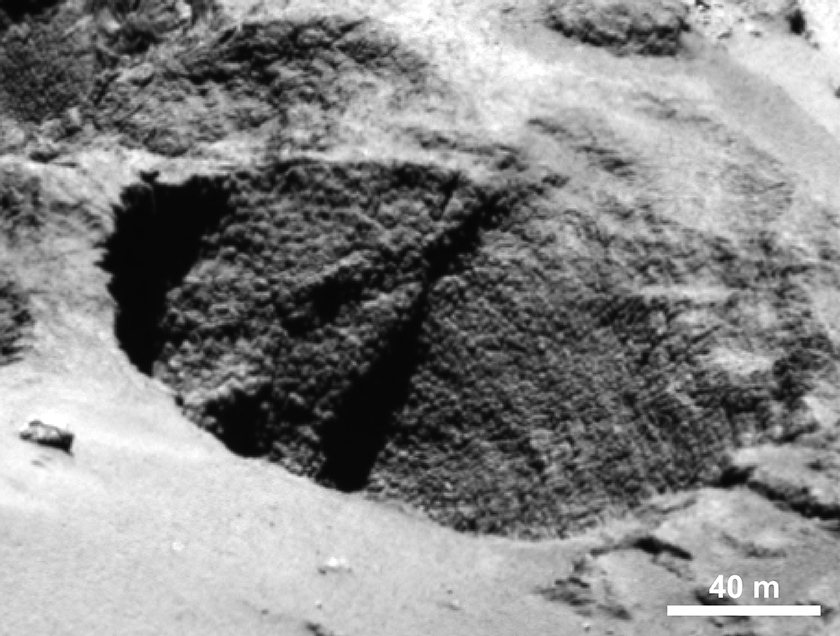
UT is about 10x the diameter of comet 67P, so, roughly, the "pits" on UT are around the size of 67P's lobes.
One big question is whether is UT is composed of 67P sized chunks, or from 10m "pebbles", or a mix of both.
Another big question is, which follows from observing the "diamond in the sky" rubble pile asteroids Bennu and Ryugu, is, what is causing the lobes of Ultime Thule to hold their shape? Are Ultima and Thule just "pebble piles" which hold their shapes because they have acquired a tholin surface skin?
Posted by: kenny Jan 3 2019, 08:36 PM
As I understand it, the Milky Way (our galaxy) is inclined at about 60 degrees to the Plane of the Ecliptic in which Pluto, Ultima Thule and New Horizons currently reside.
Posted by: Hungry4info Jan 3 2019, 08:41 PM
Right but the two planes intersect, and at that intersection, in the crowded star fields of the galactic centre, it's difficult to detect solar system bodies amidst the glitter of lights.
Posted by: dudley Jan 3 2019, 08:52 PM
Quite possible. An impact that large, in proportion to the size of Thule, might have shattered it. Is much sublimation expected at 44 AU from the Sun?
Posted by: WTW Jan 3 2019, 09:20 PM
And we need to be thinking in terms of dynamics of materials at near absolute zero. (That react differently than materials heated by high-velocity impacts, radiation, etc.) Maybe even a "low velocity" impact could add significant heat relative to those low ambient temperatures, and cause structural as well as chemical changes.
Likewise, could heating from radioactive decay of things like 26Al be very localized within those bodies -- causing such things as outgassing from certain areas and not others?
Posted by: HSchirmer Jan 3 2019, 09:35 PM
Yep, quick double-check shows that common ices are still volatile way past 44 AU.
N2 sublimation- 22 Kelvin/160AU
CO sublimation- 25 Kelvin /120 AU
CH4 sublimation- 31 Kelvin / 80 AU
https://www.lpi.usra.edu/books/CometsII/7032.pdf
Posted by: mcaplinger Jan 3 2019, 09:48 PM
Not having to have the ground in the loop to decide what to send down would be one reason. Especially when you're six light-hours away.
Posted by: Req Jan 3 2019, 10:07 PM
No need for the ground to be in the loop for the operation I described. What I described is a simple sequence of software that the spacecraft can run to produce a data product that could be less than 300 bits which would tell them if, and in exactly which images the highest resolution pass captured UT. It's not unprecedented, this has been a common practice during the opening days and hours of multiple recent missions and encounters(thumbnails in general that is, not the extra reductions I described to further minimize the size of the useful dataset in the case of this particular mission.)
Posted by: mcaplinger Jan 3 2019, 10:14 PM
Which missions are those?
Maybe they just didn't think of it or they couldn't make it fit in their FSW. There's a general bias to minimize work done on the space side even if work on the ground side is 10x harder.
We use thumbnails on MSL, obviously, but usually not to pick and choose what to send down once we see the thumbnails. Sometimes, not often.
Posted by: Req Jan 3 2019, 10:20 PM
Maybe they just didn't think of it or they couldn't make it fit in their FSW. There's a general bias to minimize work done on the space side even if work on the ground side is 10x harder.
We use thumbnails on MSL, obviously, but usually not to pick and choose what to send down once we see the thumbnails. Sometimes, not often.
MSL is the one that comes to mind instantly, however I've seen the same practice being used on Cassini for encounters, ROSETTA did it, and I just assume it's being/was used for insight, since phoenix did the same. Perhaps the piece that I'm missing is just your third sentence about 10x ground. Thanks for that insight.
Posted by: mcaplinger Jan 3 2019, 10:30 PM
Did Cassini use thumbnails? Maybe, I wasn't aware it did.
NH probably wasn't designed with a flyby of a small body with such uncertain centering in mind, I don't think they had so much of a problem at Pluto (but I could be mistaken.)
FWIW, I argued long and hard that thumbnails for MSL Mastcam were not worth implementing. In hindsight I was wrong, but the use case of ground-in-the-loop selective transmission doesn't end up getting used that often, and we had to work fairly hard to get the thumbnail products small enough to be cheaply downlinked. They are mostly useful just to show that a sequence executed as designed, but that's fairly expensive for what amounts to debugging messages (though one can amuse oneself by building mosaics of thumbnails while waiting for the full products, etc.)
Posted by: nprev Jan 3 2019, 10:38 PM
You may have answered your own question. Req. We don't know how the flight software of NH is configured, so it's possible that adding such a feature would incur operational risks that we with our limited (as in zero) understanding of the FSW do not know. Additionally, time and labor are limited resources, and presumably something like this has gotta rank pretty low on the priority list.
EDIT: I see that Mike has answered you as well.
Moving on...
Posted by: WTW Jan 3 2019, 11:18 PM
NH probably wasn't designed with a flyby of a small body with such uncertain centering in mind, I don't think they had so much of a problem at Pluto (but I could be mistaken.)
FWIW, I argued long and hard that thumbnails for MSL Mastcam were not worth implementing. In hindsight I was wrong, but the use case of ground-in-the-loop selective transmission doesn't end up getting used that often, and we had to work fairly hard to get the thumbnail products small enough to be cheaply downlinked. They are mostly useful just to show that a sequence executed as designed, but that's fairly expensive for what amounts to debugging messages (though one can amuse oneself by building mosaics of thumbnails while waiting for the full products, etc.)
Emily mentioned that histogram data are included in the image metadata that is being downloaded before the rest of the images are -- which should be enough to determine which frames contain UT image content, and to help prioritize them.
Posted by: nprev Jan 3 2019, 11:46 PM
ADMIN NOTE: Since the encounter phase and frequent press briefings are nearly over we'll be starting a new thread to discuss the flyby results as they come in over the next 20 months, similar to what was done after Pluto.
This thread will be closed in the near future.
Posted by: Req Jan 4 2019, 12:01 AM
Just to be clear, the only reason I asked the question in the first place is because during today's press conference, Alan said this:
"Yeah, we don't know that yet Ken. In order to get that, we're going to have to analyze the images that we have in a little bit more detail. But more importantly, we have to get down some engineering data that tells us about the pointing, and we have to get our next trajectory reconstruction of the first post-flyby, and to get all of those steps is going to require a couple of weeks of work after we get out of the solar conjunction that I was talking about, and at that point we will be able to calculate where in that long train of hundreds of images we will find Ultima, and then place commands in a command load for February to download only those that contain the targets." This answer seems to explicitly state that they will be doing this selection "in the loop" by Mike's above definition, regardless of the method that they use to identify the sequence numbers to grab first.
Thanks again Mike for the insight, I love learning about the details of MSL, or whatever. I really appreciate all of your responses.
I'm not trying to act like I know better, this team has my complete benefit of the doubt, I just want to learn why they didn't just write/QA some quite simple code(especially compared with the other things they have to write/QA for this mission) and then download 300-10,000 bits of data to know right now, so that they can augment their team planning, and as an extremely distant second, give a better answer to the easily predictable question that Alan answered above during their (second)15 minutes("You said you might not get the best images. Did you?")
Posted by: WTW Jan 4 2019, 04:56 AM
Re. helping to observe and measure occultations by Kuiper Belt Objects:
A major omission from my previous links:
The RECON project:
http://tnorecon.net/about-us/about-the-project/
RECON is devoted to observing stellar occultations by "Trans-Neptunian Objects" (TNOs) -- i.e., bodies whose semi-major orbital axis is greater than the semi-major orbital radius of Neptune -- and which include the KBOs.
Here is a quote from their website:
RECON — the Research and Education Collaborative Occultation Network — will involve students, teachers, amateur astronomers, and interested community members in a citizen science astronomy research project to study the outer solar system. We are providing telescopes, camera equipment, and training to over 40 schools and education centers across the Western United States so students and teachers from these communities can help us determine the sizes of objects out past Neptune through occultation measurements. To learn more about RECON, visit http://tnorecon.net/
Funded by the National Science Foundation, RECON is run by planetary scientists Marc Buie from Southwest Research Institute and John Keller from California Polytechnic State University.
You can sign up to join their project or request more information at
https://docs.google.com/forms/d/e/1FAIpQLSc-HpNaUKqhUPG2WQO4Tb9iSvV8j5IrX5o7-iOKEh236b7X9g/viewform
Posted by: john_s Jan 4 2019, 11:16 AM
A few points-
- One additional big reason why we can't get down the highest-resolution images earlier, is that they are stored on the second solid-state data recorder (SSR2), which we can only access when we power up the backup computer, Given our tight power budget and other complexities (e.g. additional housekeeping data are generated and need to be downlinked when the backup computer is is powered up), we have to wait a while to power up that computer again to get at the SSR2 data.
- The command loads, which each cover 2-3 weeks of spacecraft activities, are developed over a cycle that starts well over a month before execution. So to downlink jailbars and use the m to determine which images to send down wouldn't be any faster than what we're currently planning.
- Yes, we get down histograms for each LORRI image, but they are quantized in a way that means that a faint target like Ultima doesn't show up in the them, in the short exposures needed for our highest resolution images. So histograms don't tell us which images contain the target.
- Adding the capability to generate and downlink thumbnails, like any flight software change, would take months to develop and test to ensure it was bulletproof. Given our small team, it wouldn't be a good use of resources.
- Like Alan said, New Horizons is a mission of delayed gratification. Patience is a key requirement.
- The best illustration of the quality of the best images we hope to get is the Phobos-based simulation that I showed on NYE, which includes the actual expected smear and noise levels. The Manhattan image is hot intended to be a high-fidelity simulation.
John
Posted by: Steve5304 Jan 4 2019, 01:24 PM
any targets after Ultima Thule?
Posted by: nprev Jan 4 2019, 01:34 PM
Thank very much, John, and congratulations! ![]()
Posted by: jasedm Jan 4 2019, 05:00 PM
Second that - thanks John.
We're like a hoard of excitable kids who just want the party bag, with (for the most part) little conception of the effort and work involved in organising the party.
![]()
Posted by: pioneer Jan 4 2019, 05:02 PM
I learned to be patient from the Galileo mission.
Posted by: ElkGroveDan Jan 4 2019, 05:26 PM
John
Thanks for taking the time to weigh-in with us John during what must be the week of a lifetime for you. You guys and gals are amazing!
Posted by: JRehling Jan 4 2019, 07:16 PM
I always keep handy the January 1977 National Geographic issue that was my first major source of results the Viking mission, six months after Viking 1 landed. To paraphrase Bane, "I was born in patience, molded by it. I didn't see quick results until I was already a man."
Thanks enormously to the whole team and everyone involved!
Posted by: avisolo Jan 4 2019, 08:01 PM
Thanks to the entire New Horizons team for this astonishing achievement!
As for the next target, my humble suggestion is: a photo of Earth, surpassing Sagan's Pale Blue Dot shot.
I understand that it entails a level of risk, but capturing such a prospect would be an inspiring legacy if you manage to pull it off. Our planetary survival challenges are very acute and near-term and we humans need all the inspiration we can get asap.
Posted by: Explorer1 Jan 4 2019, 08:17 PM
I believe Alan said they will wait until they're sure they will not have any encounters before attempting this; apparently the Sun is still bright enough to damage LORRI in case of accidental pointing (for Voyager's portrait this was not an issue).
Posted by: HSchirmer Jan 4 2019, 08:32 PM
I kinda-sorta got the feeling that NH team wants to hold that photo until the 2030s when their Cassini-RTG has nothing better to do.
Which reminds me, as to getting data down- has anybody floated any wild plans for "rose petal" 70 meter class double-dish DSN relay? Put a matched pair of 70 meter radio telescope out Saturn, Uranus or Neptune? Provides 70 meters looking out, 70 meters of data relay back towards earth.
Posted by: serpens Jan 4 2019, 10:00 PM
Another encounter would be amazing.
Posted by: neo56 Jan 4 2019, 10:21 PM
Denoised version of the latest picture of Ultima Thule with starfield and cropped and colored version.
https://www.flickr.com/photos/thomasappere/46553320762/sizes/o/
https://www.flickr.com/photos/thomasappere/31664271577/sizes/c/
Posted by: MahFL Jan 5 2019, 02:14 AM
They will use LORRI to look for targets.
Posted by: Roman Tkachenko Jan 5 2019, 03:49 AM
Composite image of Ultima Thule.
Posted by: nprev Jan 5 2019, 06:46 AM
Looks like a good time & place to start moving the discussion over to the new http://www.unmannedspaceflight.com/index.php?showtopic=8454&st=0 topic.
This topic will be closed and archived on 6 Jan. Thanks. ![]()
Posted by: wildespace Jan 5 2019, 07:08 AM
Trying to simulate "true colours" by using red and blue-filtered frames, with a synthetic green channel:
There seems to be some colour variation, with bluer areas around the "neck".
Posted by: Floyd Jan 5 2019, 08:42 AM
They will use LORRI to examine known objects and get light curves and other information.
To find new potential objects to visit next will require getting an extension of the mission approved and getting time on Hubble and terrestrial big scopes to search for objects that they can reach. They will then need to determine the new objects orbit precisely with star occultations---ie a repeat of how they found 214 MU69 and got its orbit.
Posted by: Therion Jan 5 2019, 12:20 PM
Actually, according to Alan Stern's post in "KBO encounters" thread, they will use LORRI to search for another targets : )
So we would have to detect it with LORRI on New Horizons itself, which can see 3-10 km targets up to about 6 months ahead of us. Feasibility calcs will be done in 2019 (preliminary calcs are pessimistic but we really haven't scoured this to a solid conclusion). We'll see if this can work-- I hope so. It would be very cool to detect and target all from New Horizons with a "target of opportunity" flyby sometime n the 2020s!
Posted by: HSchirmer Jan 5 2019, 03:52 PM
Yes, at this point in time, our best "eye on the Kuiper belt" is on the spacecraft IN the Kuiper belt;
in an odd way, it's interesting, frustrating, and exciting; all at the same time.
The /possibility/ versus practicality of NH finding its own targets has been the focus of a bit of discussion over the years: speculation kicks up every few years, as necessity prods invention.
As of 2012, HST was a better telescope...
Aug 23 2012, 05:13 AM
Right, our camera aperture is small enough that even though we're closer to the KBOs there's no advantage to searching from the spacecraft. Plus our maximum exposure time is 10 seconds compared to the hours we can integrate from the ground, and it takes thruster fuel to hold the spacecraft steady during those 10 second exposures, so we can't take too many of them. Oh, and because of the need to use thrusters to hold the spacecraft steady, our best spatial resolution for those long exposures is about 4 arcseconds, compared to the ~0.6 arcseconds we can get from the Earth (on a good night). The lower spatial resolution makes it difficult to distinguish and KBOs from all the background stars.
New Horizons would have a sensitivity advantage for KBOs that are very small and close to the spacecraft, as algorimancer says, but we don't think there are many of those, and we don't have the onboard smarts to find them autonomously in the images onboard the spacecraft, and we don't have the bandwidth to send enough of them back to Earth for processing even if we could afford the fuel for all those long exposures...
So we'll just have to keep searching with the big telescopes here on Earth.
John
Now, as of 2019 LORRI is functionally better than HST, so you just use the best scope you've got,
at least until JamesWebb is up and running....
Posted by: ZLD Jan 6 2019, 02:12 AM
I hadn't heard that limitation of LORRI before. Is that due to a memory buffer limitation?
Posted by: HSchirmer Jan 6 2019, 04:44 AM
That seems to be more of a practical limit due to the object moving during flybys, a few sources indicate the exposure limit is actually 29.9 seconds-
http://spaceflight101.com/newhorizons/instrument-overview/
IIRC, the optics were optimized to take low-light fly-by pictures of Pluto, trying to stare at a patch of sky and build up an image of KBOs photon-by-photon wasn't in the design specifications.
Posted by: nprev Jan 6 2019, 09:03 AM
Great encounter, and now it's time to archive this topic and move the discussion over to http://www.unmannedspaceflight.com/index.php?showtopic=8454&st=0 for ongoing discussion as the data comes down for slightly less than the next two years. ![]()
Powered by Invision Power Board (http://www.invisionboard.com)
© Invision Power Services (http://www.invisionpower.com)

